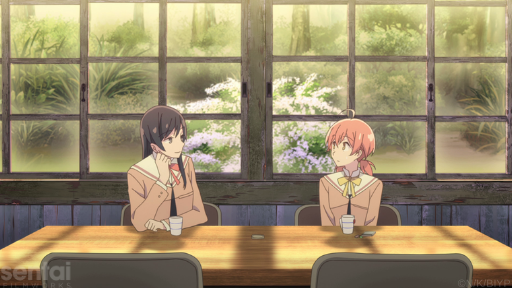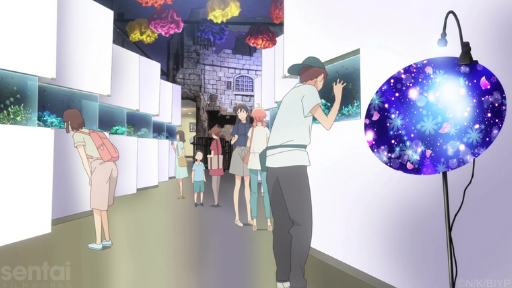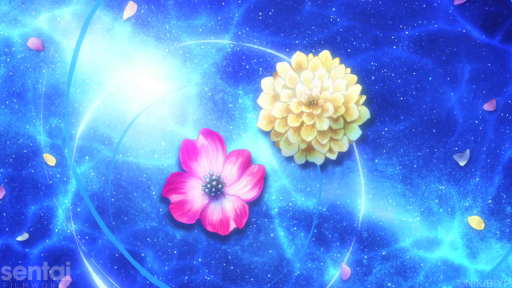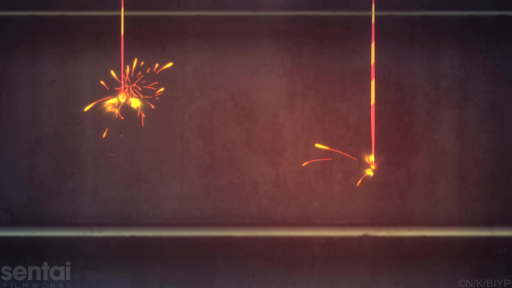
Floral Symbolism in “Bloom Into You”
The floral symbolism in Bloom Into You simply cannot be denied. From the anime’s title to its evocative, flower-filled OP, floral symbolism runs through the very soul of Bloom Into You. But what do the flowers reveal about the series, and how do they enhance the plot and characters of Bloom Into You?
Spoilers ahead!
Sakura Signals Internal Change

One of the first flowers to appear in Bloom Into You is the sakura, or cherry blossom. Boughs thick with cherry blossoms rain a storm of petals over Yuu as she hears a love confession from a male classmate — but although the cherry blossom can mean "love" in some flower languages, among other interpretations, Yuu feels nothing for this young man. But why do cherry blossoms appear in this scene? Do they symbolize love here?
Not quite. In Japanese hanakotoba, cherry blossoms are notable symbols of transience and the fleeting nature of life. Just as the cherry blossoms can bloom one moment and fall from the branch the next, her friend’s confession alters Yuu’s perceptions of love and romance in a single, sudden instant.
Red Flowers Stand at the Student Council’s Door

When Yuu enters high school, she’s asked to help out with the student council, and soon she meets Touko Nanami. As Touko welcomes Yuu into the student council room, behind her stands a shrub bearing beautiful red blossoms. This bush makes many appearances throughout the anime, and it bears one of two possible flowers: Japanese quince (Chaenomeles japonica) or red azalea blossoms.
Either of these flowers offers a glimpse of what’s to come should Yuu follow Touko into the council room. Japanese quinces represent love at first sight and sincerity, while azaleas in hanakotoba refer to temperance and patience — a reference to the slow journey of Yuu’s heart as she puzzles out what it means to fall in love.
Wisteria Watches Over Them

After hearing that love confessions have never made Touko’s heart flutter, Yuu approaches her for advice over a cup of tea. She believes Touko is a kindred spirit, but Touko soon confesses that she isn’t a stranger to love like Yuu thinks she is. In fact, by the end of their chat, Touko confesses that she’s falling in love with Yuu — and during this exchange, a blooming wisteria plant watches over them.
Wisteria flowers have long played a role in Japanese culture. A long-lived plant, wisteria symbolizes longevity along with steadfast devotion and an expression of affection upon meeting someone new. A famous Kabuki dance, “Fuji Musume” (“Wisteria Maiden”), adopts the wisteria flower as a symbol of love. Wisteria’s placement in a scene characterized by emotional vulnerability and bonding shows that Touko and Yuu’s budding relationship has the potential to bloom into something more.
Hydrangeas Reveal the Heart

Episode 8 calls out the hydrangea flower on three separate occasions, and contrasting the three scenes in which the flowers appear reveals the reason for their prominent placement throughout the episode.
During the first scene, the camera cuts to an image of white and blue hydrangea flowers after Sayaka uses Touko to get revenge on a former girlfriend. Touko points out the flowers and asks which is Sayaka’s favorite color. White hydrangeas can mean ‘boastful,’ while blue hydrangeas can convey rejection and regret — a fitting combination considering the way Sayaka used Touko and that her affections for Touko go unreciprocated. We don’t get to hear which color Sayaka prefers, but the mention of the flower is pointed.
In a later scene, Sayaka and Yuu discuss their respective feelings for Touko. As they walk home, Sayaka asks Yuu about her favorite color of hydrangea. Again, we don’t hear the answer, but the flowers in this scene are pink and white. Pink hydrangeas are an indicator of sincere emotion, and the sincerity Sayaka and Yuu shared whilst discussing Touko, it’s clear these colors were chosen with care, and we can surmise her internal conflict based on the choices laid before her.
In the third and final scene incorporating hydrangeas, Yuu and Touko walk home together during a downpour. The pair stops to take shelter from the rain, where they share a vulnerable expression of their feelings and Touko asks forgiveness for potentially taking advantage of Yuu’s kindness. This scene plays out atop a backdrop of blue and purple hydrangeas. Since purple hydrangeas convey a desire for deeper understanding and blue hydrangeas have an alternate meaning of forgiveness, these colors highlight the nuances of the scene and the internal feelings of the characters therein.
The Blue Rose of Perfect Love

In the final episode of Bloom Into You, Yuu and Touko visit an aquarium together. Gigantic false roses adorn the ceiling, watching over them as they share an afternoon and speak with one another about falling in love, identity, acceptance and their feelings for one another.
The roses in this sequence come in a range of colors. The red rose’s classic “I love you” meaning is, perhaps, the most recognizable, but the other roses present in this scene also bear mentioning. White roses can mean “devotion” while pink roses can convey happiness, but the prominently placed blue rose draws our focus most of all. Blue roses are symbols of perfection, hence why they appear in fairytales and stand for “perfect and fulfilled love.” For that reason, it’s no surprise that a blue rose presides over Yuu and Touko’s final date in the anime.
The Roots of the Floral Symbolism in Bloom Into You Run Deep

In Bloom Into You, flowers may occupy the background of a scene, but their impact resonates throughout the series. We covered only a small portion of the floral symbolism in Bloom Into You, and there are no doubt many more flowers with hidden meanings scattered throughout the series. Each one was chosen with care, and viewers who dig into even the smallest details of Bloom Into You will find a wealth of hidden meanings just waiting to be discovered.
Want to snag your very own copy of Bloom Into You? The limited edition drops today, so be sure to pick up the box set or the Complete Collection so you can bask in all the floral symbolism.
Enjoy reading about these Bloom Into You flowers? Think we missed an important flower placement? Let us know by tagging @SentaiFilmworks on social! Don’t forget to sign up for our newsletter, too!
Honorable Mention: Hanabi, the Fire Flower

Japanese spells the word for firework, “hanabi,” with the characters for “fire” and “flower,” and we couldn’t resist talking about the symbolic meaning of this unconventional flower here.
In episode 11, the members of the student council burn “senko hanabi,” or Japanese sparklers, together on a summer night. Senko hanabi capture the fleeting beauty of life and mimic the five stages of the human life cycle; the random nature of their sparks represents the irregularity of life’s events. They are meant to be watched in a meditative or introspective state, one that should invoke the feeling of gentle mono no aware in the viewer.
During this scene, Sayaka and Touko burn senko hanabi together as Sayaka asks Touko about a boy named Ichigaya, a member of the student council from seven years prior. He spoke with Touko earlier in the episode about her sister, who has since passed away. Sayaka confesses that she knew about Touko’s sister, and Touko accepts Sayaka’s worry for her calmly and with gratitude. Their conversation about the births and deaths of student councils old and new, carried out over a backdrop of burning senko hanabi, encapsulates the very concepts the sparklers are meant to convey — and in turn shows the depth of thought that went into staging the anime as a whole.